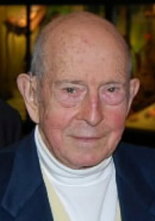Nabisco heir, Ohio industrialist, and environmentalist
Talbott, known as Bud, was involved in several Cleveland companies but was better known for his decades of work to preserve the environment. He served on the boards of organizations such as the Cleveland Zoological Society and the Cleveland Museum of Natural History and was founder of the Ohio Conservation Foundation. Talbott was born in Dayton. His father served in three wars, World War I, World War II and the Korean War, and finished with the rank of Brigadier General. His grandmother was the founder of Westminster Choir College, which is now in Princeton, N.J. His grandfather founded National Biscuit Co. Talbott attended public schools in Dayton before earning his bachelor's in industrial administration and engineering at Yale in 1942. He was on the football, track and swimming teams at Yale. He was also in the U.S. Navy, serving in the North Atlantic and English Channel on fleet rescue tugs during World War II. He married Josephine Large in 1943 and they moved to Dayton in 1946, where Talbott worked for his father at his real estate and venture capital company. In 1952, he moved on to Harris Corp. in Cleveland (known then as Harris Seybold), where he worked for seven years in various roles, including director of industrial development. Then in 1960, Talbott joined Prescott & Co. in Cleveland, which later became Prescott, Merrill, Turben & Co. He became president and CEO of Prescott in 1970 and under his leadership, the company grew from 130 employees to 850. He left Prescott in 1979 and became chairman of a consulting firm, Strategic Planning Associates, based in Washington D.C. Talbott kept an office in Cleveland. In 1983, Talbott led a group of investors who bought Sawyer Research Products in Greater Cleveland, and he became chairman and CEO. He retired as CEO 10 years later but remained as chairman. He was also on the board of the Chagrin River Land Conservancy and served on the national boards of Ducks Unlimited, the World Wildlife Fund, the Environmental Law Institute, the Environment and Energy Study institute and the Yale Institute for Biospheric Study.
